skip to main |
skip to sidebar
Leaving Syuru and heading for Triton Bay : Sunday, 1st February 2015
Before our ship departed for Triton Bay, we had an Early Morning Zodiac Cruise. We left the ship and headed towards Syuru village where we’d had such a remarkable visit the previous afternoon.
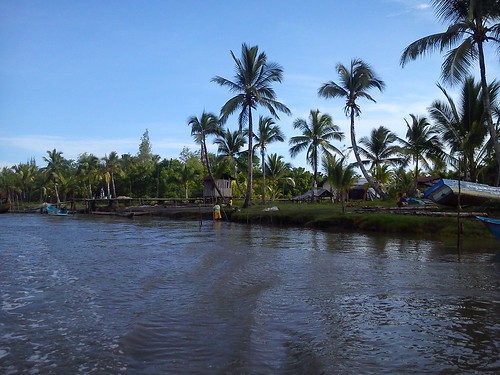 View of part of Syuru village from the Creek.
View of part of Syuru village from the Creek.
This time, it was much quieter. Because it was near high tide, the mudbanks which had been such a feature of our arrival the previous day were covered in water. We were able to continue up the creek on our right and on our left past part of the village which was just waking up. We exchanged greetings with some of the villagers before crossing to the right hand side of the creek to study the mangroves. The Asmat Swamp is a wetland sometimes claimed to be the largest alluvial swamp in the world. It is a diverse area. The creek we were on was, of course, tidal so the dominant species were the mangrove and the nipah palm which have adapted to a saline environment. For more information about these interesting adaptations, see the Wikipedia articles Mangrove and Nypa fruticans.
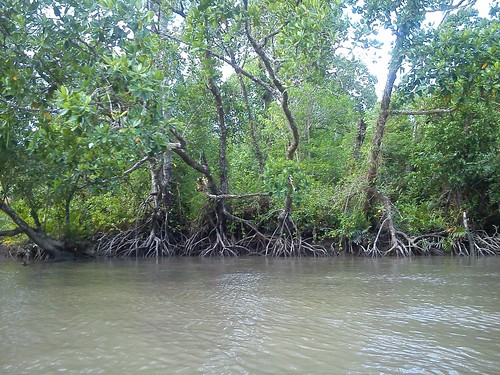 The distinctive appearance of Mangroves with the 'root system' lifted out of the water.
The distinctive appearance of Mangroves with the 'root system' lifted out of the water.
Inland, the swamp is fresh-water allowing a wider variation of vegetation to develop. After an interesting cruise along the creek, we returned to the ship at 9.00 a.m. The ship’s funnel was already emitting dark smoke, suggesting that the main engines had been recently started prior to getting under way on the next leg of our voyage – the 283 nautical miles to Triton Bay.
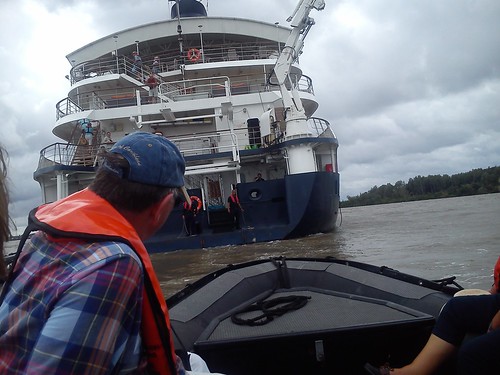 Approaching the special "marina deck" incorporated into the stern of 'Caledonian Sky'.
Approaching the special "marina deck" incorporated into the stern of 'Caledonian Sky'.
During the day, there were three lectures on diverse topics but I was still trying to document our earlier adventures and transfer my photographs onto my notebook computer for safe keeping. Later in the afternoon, there was time to visit the Bridge. During daylight when the ship was underway in 'open water', there was an "Open Bridge" policy, so I was a fairly frequent visitor.
 View of the Arafura Sea from the Bridge, late afternoon on 1st February 2015.
View of the Arafura Sea from the Bridge, late afternoon on 1st February 2015.
Triton Bay : Monday, 2nd February 2015
We were still travelling towards Triton Bay when I took breakfast on Monday.
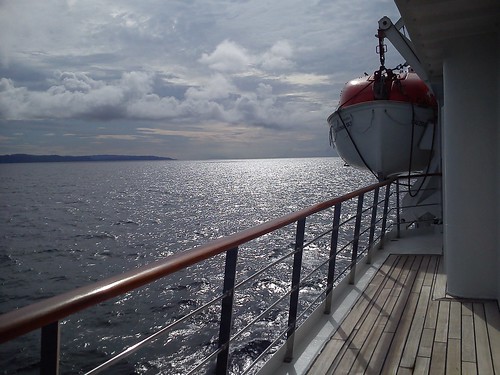 Nearing Triton Bay, early morning, 2nd February 2015.
Nearing Triton Bay, early morning, 2nd February 2015.
At 9.00 a.m., I attended the lecture by Lea McQuillan, a naturalist from the ship’s Expedition Team, about the Coral Triangle. By the time this interesting lecture was complete, the Captain had moored at Triton Bay in deep water and the Zodiacs were being made ready to offer a Zodiac cruise of Triton Bay.
Zodiac Cruise
We set off by Zodiac for a network of small islands in Triton Bay, limestone pillars fringed with trees struggling to remain attached. Tidal action had eroded the limestone at water level so as to undercut the pillar, leaving the columns balanced on a much smaller base.
 Passing between two limestone islands, showing the remarkable 'undercutting' at water level.
Passing between two limestone islands, showing the remarkable 'undercutting' at water level.
The Zodiac enabled us to examine the trees and flowers on the islands close-up. At one point, there was a cave large enough to actually take the Zodiac inside. The area only seemed suitable for craft like the Zodiacs but suddenly a large passenger vessel appeared, the K.M. ‘Wally Philan’ and sailed right past us. There were at least a couple of hundred local people on the foredeck, the roof of the superstructure and the afterdeck, all apparently delighted to see us, waving and cheering. Our 'local expert', Oswald, from Destination Asia, confirmed that it was a regular ferry service. The 'K.M.', he said, stood for 'Motor Ship' and the name would be the owner's name.
 Lots of enthusiasm, not so much Health and Safety.
Lots of enthusiasm, not so much Health and Safety.
Ashore in Triton Bay
After lunch, the Zodiacs took us to a sandy beach where we disembarked into water a few inches deep (a ‘wet landing’) The weather was good and there was a narrow beach of fine, white sand leading to the water’s edge, allowing both swimming and snorkelling. But a number of people reported that the pull of the tide was greater than expected and, after a bit of floating around, I found that I was getting buffeted by the tide so I retired to the sand. Later, I walked the extent of the beach with some of the ‘beachcombers’ from the passengers.
On to Andamatta and Kokas
Once again, the ‘Caledonian Sky’ sailed overnight to our next destination – this time Kokas and Andamatta. I’ll tell you more about that area next time.
You can find all the posts on this trip here.
My pictures
Triton Bay.
[Minor revisions, pictures and links to pictures added 24-Feb-2015]
Syuru and Agats: Saturday, 31st January 2015
As our Zodiac approached the shore, we could see a large number of dugout canoes, each made from a single tree-trunk which I estimate was 15 to 20 feet long and quite narrow. Each was being paddled towards our group of Zodiacs by a number of standing men using simple wooden oars. There were also crowds of men gathered on the shore. They were all chanting in time with a drumbeat from the shore, each rower thrusting his oar vertically down into the water before levering the craft forward.
The first boat to reach us was much larger than the other boats but still long and thin. I think it was of wooden plank construction – it was certainly propelled by an outboard motor at the stern. There were three men in modern dress plus one in a tribal costume, clearly a Chief. The Chief was a commanding figure, dressed in a long grass skirt, bare chested but wearing a traditional headpiece with two white, fringed extensions, like horns. As he chanted, he periodically punched the air with one arm. His exposed coffee-coloured skin had been covered with traditional markings in white on his face, arms and torso.
The dugout canoes surrounded our Zodiacs and stopped paddling but kept up the rhythmic chanting. Each canoe had two or three rowers and all were in a version of tribal costume, ranging from simply body painting with a pair of modern mid-length sports shorts to variations on the Chief’s attire with long grass skirts, head pieces and body painting. The body painting was in apparently individual styles including completely white-face, a white ‘U’ on the lower face (like a beard) or a ring around the eyes. Some of the men also had red body paint in addition to white. In the bewildering variety of this melee of boats, with the incessant chanting, it was difficult to make observations. If the ceremony had originally been intended to terrify visitors, it was certainly successful – this was the most fierce-looking welcome I have ever had. Some of the canoes also had passengers in the form of boy children too young to be rowers but adorned with body painting. We tried to count the number of canoes involved, but with all the activity, the best answer was “more than 40”.
 Part of the 'welcoming committee' in dugout canoes.
Part of the 'welcoming committee' in dugout canoes.
The village lay ahead of us, served by a rather ramshackle jetty leading down to what would have been water had the receding tide not left a muddy gap of about thirty yards. The Zodiac was beached and we started to wonder how we would ever get to the jetty, but our hosts, men and boys, enthusiastically jumped into the mud and surrounded our craft, hauling it slowly across the mud to the landing stage. Our helpers were sinking into the mud up to their knees – grey, particularly glutinous stuff formed from fine grains of sand.
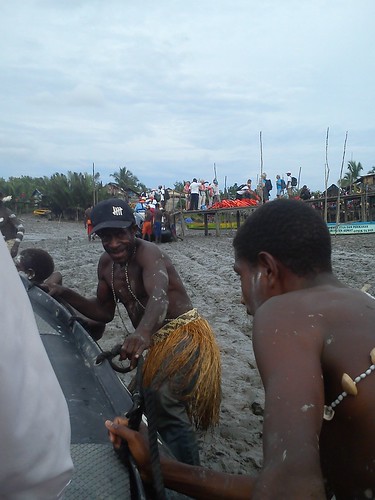
My Zodiac being hauled across the mud to the landing stage.
With a lot of heaving on their part, we arrived at the landing stage. The first few feet of the landing stage was wooden steps, formed from two inclined uprights connected by rather nobbly timber steps, about two or three inches diameter. With help from ‘human handrails’ we all made it safely onto the boardwalk leading to land. We couldn’t move very far because the passengers from earlier Zodiacs had been positioned onshore in the available space, leaving later arrivals to line the jetty.
Throughout our undignified landing, the crowds of men onshore who were dressed and painted like the canoe rowers danced and chanted, working themselves into a state of some excitement. A few of the men demonstrated what we now describe as “twerking”. Although my position on the jetty gave me good views of the later parts of the ceremony, I couldn’t see much of the dancing. It was only afterwards that I found out that there had been a separate section with local women dancing – what I saw was completely male-dominated.
There were a number of men from Noble Caledonia’s Land Agent on hand, one of whom had a battery-operated public address and was providing a running commentary on the proceedings. With all the noise from the dancers, it was a while before I realised his commentary was in English but I eventually grasped that, in addition to the welcome to Noble Caledonia, a traditional ceremony for the launching of a new dugout canoe was in hand. After some palm fronds had been thrown around, a new dugout canoe emerged from the milling dancers, being carried by at least 30 men. The canoe had been painted white with vertical red stripes along its length. A large man wearing very skimpy underpants with a grass skirt and, inexplicably, a bra was standing balanced on the gunwhales of the canoe as it was carried across the mud to the water's edge and placed in the water.
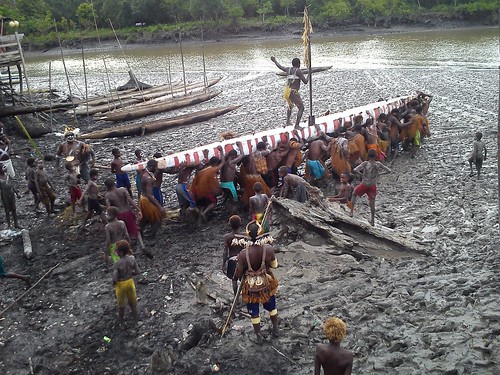 The first new dugout canoe being carried to the water's edge.
The first new dugout canoe being carried to the water's edge.
We were not finished yet. More palm fronds were being tossed aside. It appears that it is customary to complete the boatbuilding ‘in secret’ and a temporary fence was being removed from around three more new canoes and the palm fronds discarded, having served their traditional purpose of keeping the new dugouts from prying eyes. The ‘launching’ we’d just watched was repeated three times, with great enthusiasm. Each time there were at least 30 men to carry the canoe, with one man standing on the gunwhales, in his particular variation of traditional dress, encouraging the boat carriers.
 Villagers prepare to 'unveil' another new dugout canoe.
Villagers prepare to 'unveil' another new dugout canoe.
It’s hard to estimate how many people participated in the chanting and dancing. But it must have been between two hundred and three hundred at least. We were told that three villages combined their efforts to perform this ceremony. All the villagers not involved in the ceremony were watching from various vantage points. All the passengers had been very impressed by the amazing experience and the expedition crew who, of course, are widely travelled agreed that they had never seen such a spectacle.
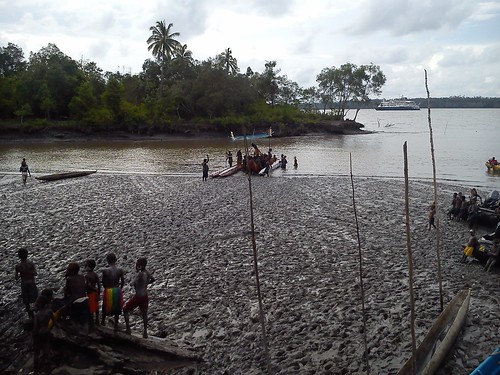 The last of the new dugout canoes is lowered into the water. In the foreground, the muddy 'beach', in the background 'Caledonian Sky' awaits our return.
The last of the new dugout canoes is lowered into the water. In the foreground, the muddy 'beach', in the background 'Caledonian Sky' awaits our return.
We slowly moved away from the landing area and proceeded along the boardwalk through the village. The houses were wooden and built on wooden piles. Most roofs were corrugated iron but a few used thatch. At one point, we passed a pushcart carried on two bicycle wheels, brightly painted and marked ‘BAKSO’: this was the mobile shop. Periodically, we passed a modern addition – solar-powered street lamps. We crossed a muddy creek with a wide variety of outboard- or inboard-powered craft. There were lots of villagers about, curious about their strange-looking visitors but not unfriendly. Children, in particular, were intrigued but readily responded to a wave or a kind word and, from time to time, I found myself with a small band of followers.
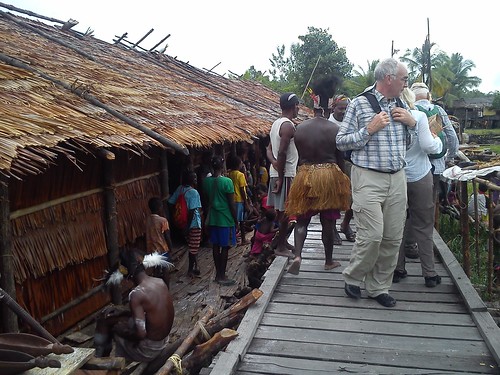 The area is famous for woodcarvings in a 'primitive style' which some villagers displayed for sale. We were told that the 'Long House' on the left was a dormitory for unmarried young men.
The area is famous for woodcarvings in a 'primitive style' which some villagers displayed for sale. We were told that the 'Long House' on the left was a dormitory for unmarried young men.
There were not just local people moving in both directions on foot along the boardwalk. Some used bicycles but there were also what looked like mopeds but were actually powered from a rechargeable battery and thus very quiet, except that, as their wheels passed over the individual slats forming the surface of the boardwalk, they produced a distinctive ‘clack-clack-clack’sound.
Continuing our walk, we passed the local power station. A dull roar from one or more diesel alternators came from inside one of a group of wooden buildings. A number of oil drums were stored on a wooden platform outside. Another part of the storage platform had a number of large distribution transformers, ready for installation.
We came to a large, wooden private house on wooden piles painted rather oddly in purple and pale blue. What caught my eye were two ‘ham’ amateur radio station signs marked ‘STASIUM RADIO AMATIR’ and the ‘call signs –‘YD9SWQ’ and ‘YD9STG’. Of course, there were quite substantial antenna installations in the garden.
After we passed an Indonesan Christian church built of wood and crossed another muddy creek, we traversed a short rural area before the buildings started again. I imagined we were now in Agats, but I couldn’t find confirmation of this, except that the boardwalk changed to an all-concrete construction supported on round columns. The actual walking surface was formed from concrete ‘paving slabs’ where the electric mopeds now produced a sort of ‘tung-click-tung-click’ as each slab rocked slightly.
On our right, the cathedral church (‘KATEDRAL’) was a striking modern design in the form of an inverted ‘V’. The broad boardwalk platform in front of the cathedral was wooden-slatted. Part of the area was marked out in white forming a series of small ‘parking bays’ for the electric mopeds. On the opposite side of the main boardwalk, there was a carved Calvary, illuminated by a single pendant electric light.
 The Cathedral Church.
The Cathedral Church.
We were invited to look around the Museum of Local Art. This was a large, airy building but rather gloomy. Although there were large windows at high level, it was starting to get dusk and there were very few electric lights in use. However, there was a wide range of carvings in the local 'primitive style' on display.
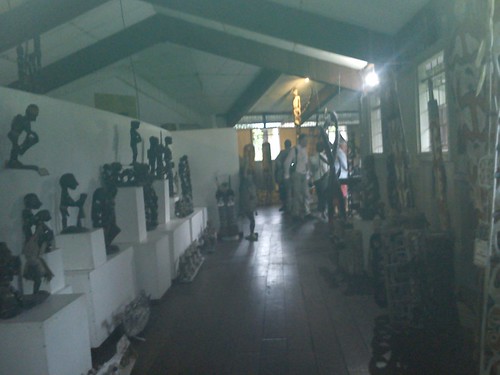 The Museum of Local Art.
The Museum of Local Art.
The Bank building on our left was distinguished by a series of flagpoles with brightly-coloured advertising flags on either side of the access boardwalk. After passing over another muddy creek with a variety of beached boats, I noticed that the shop on our right extended back some distance and seemed to be carrying very comprehensive stocks.
The next group of buildings on our right formed Agats Hospital. The Blood Transfusion Unit was particularly smart, wooden with a corrugated iron roof, pale green window frames and varnished wooden wallo cladding. There was even at least partial air conditioning. A young man approached me and, in excellent English, told me I should speak to the Doctors and find out more, pointing to a group of three people sitting under a verandah. I did so. All three were Doctors at the Emergency Unit which I was told had six beds. The main hospital adjacent had about 20 beds.
 A view of part of Agats Hospital.
A view of part of Agats Hospital.
At a crossroads in the boardwalk, there was a large piece of 'public art'. From each of the four corners of the crossroads, a curved pillar rose, joining the other pillars to form a series of arches, topped with a statue.
We passed a large, low building I took for a school because of the flagpole and the large wooden platform in front which looked like a ‘playground’. Another commercial building on our right was ‘AGATS STUDIO FOTO’ offering a Fuji film Digital Imaging Service. The large AN-NUR Mosque we passed was painted in traditional pale green and white.
We were then in what was certainly ‘Downtown Agats’ – shops on both sides of the boardwalk selling a bewildering array of goods. We saw one young man who’d presumably caught the ugly-looking catfish he was carrying. It was about three feet long and he was happy to pose for photographs. One café had a barbeque outside being prepared for action, fired with coconut shells.
 'Downtown Agats'.
'Downtown Agats'.
Now almost dark, we arrived at the shore. There was a substantial high-level concrete jetty to accommodate the larger ferries which serve Agats but there was also a low-level jetty for local boats where we joined our ‘Zodiacs’ for the journey back to our ship. The jetty area was crowded with local people, many of whom had come to see the foreigners and it was quite a jolly send-off.
 Queuing for 'Zodiacs' on the local jetty, watched by a crowd of locals on the high-level jetty.
Queuing for 'Zodiacs' on the local jetty, watched by a crowd of locals on the high-level jetty.
A most memorable experience. Next time, I’ll describe our Zodiac cruise the following morning to study the Mangrove Ecosystem around Syuru. You can find all the posts on this trip here.
My pictures
Syuru.
[Minor revisions, pictures and links to pictures added 23-Feb-2015]
 View of part of Syuru village from the Creek.
View of part of Syuru village from the Creek.
 The distinctive appearance of Mangroves with the 'root system' lifted out of the water.
The distinctive appearance of Mangroves with the 'root system' lifted out of the water.
 Approaching the special "marina deck" incorporated into the stern of 'Caledonian Sky'.
Approaching the special "marina deck" incorporated into the stern of 'Caledonian Sky'.
 View of the Arafura Sea from the Bridge, late afternoon on 1st February 2015.
View of the Arafura Sea from the Bridge, late afternoon on 1st February 2015.
 Nearing Triton Bay, early morning, 2nd February 2015.
Nearing Triton Bay, early morning, 2nd February 2015.
 Passing between two limestone islands, showing the remarkable 'undercutting' at water level.
Passing between two limestone islands, showing the remarkable 'undercutting' at water level.
 Lots of enthusiasm, not so much Health and Safety.
Lots of enthusiasm, not so much Health and Safety.











